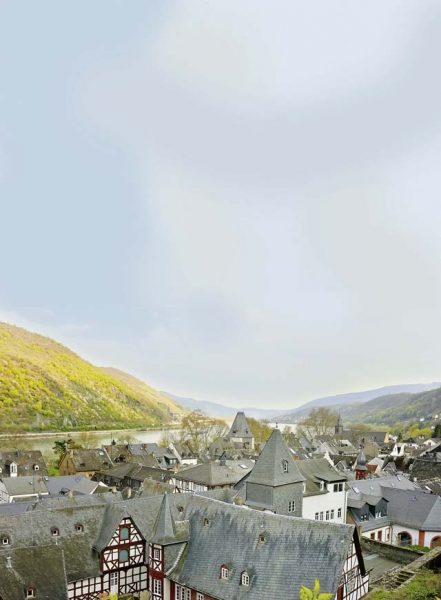The Rhine River offers a magical German experience with its breathtaking scenery, half-timbered houses, historic castles, dramatic hillsides and delicious wines. May to mid-October is the perfect time to explore the Rhine, as most places all but shut down during the winter months. Here are three stops along the Rhine River you will not want to miss out on.

Saint Goar
Just over an hour’s drive from Kaiserslautern, sightseers can explore Saint Goar, a Rhine River town first settled during Roman times.
The town was named after Goar of Aquitaine, a young monk who came to live on the site around 530. Goar lived as a hermit in a cave on the Rhine, working as a missionary to the local people. Goar was famous for his great hospitality, particularly towards the boatmen on the Rhine. Over the years, many tales have been told about Goar of Aquitaine. After his death in 575, his resting place became a pilgrimage site, and the town was named after him.
While in Saint Goar, sightseers can visit Rheinfels Castle, which dates back to 1245. In its prime, Rheinfels Castle covered five times its current area. It is the largest castle overlooking the Rhine.
One of the most famous points near the town is the site of the Lorelei rock. The myth tells a story of a beautiful woman named Lore Lay who betrayed her sweetheart. She was accused of bewitching men and causing their death. Rather than sentence her to death, the bishop committed Lore Lay to a nunnery. Three knights accompanied Lore Lay on her journey to the nunnery. When they came to the rock, Lore Lay asked the knight’s permission to climb it and view the Rhine one more time. In doing so, she thought she saw her love in the Rhine and fell to her death. According to the legend, the rock echoes the sound of her name. Many believe Lore Lay distracts shipmen with her beauty and her singing, causing them to crash onto the rocks.
Bacharach
Just a little over an hour’s drive from Kaiserslautern, Bacharach offers historic streets, half-timbered houses, historic churches, great wine and Stahleck Castle.
Many cozy street-side cafes offer local wines as well as delicious regional specialties including Rhine goat and local game. After a yummy meal, families can enjoy a scenic hike along one of Bacharach’s many routes.
No day excursion is complete in Germany without visiting a castle or two. Standing commandingly on a riverside crag is Stahleck Castle, a 12th-century fortification. During World War II, Stahleck became one of 27 “jugendburgen,” or “youth castles,” used for the indoctrination of teenagers and young adults. From 1940 to 1943, the castle served as a military hospital. In January 1943, the castle was used as an internment camp for German youth who exhibited disloyalty to the Nazi Party, some of which were taken from Stahleck to concentration camps. From June 1943 until the following summer of 1944, Stahleck was used as a work and military training camp for Germans between the ages of 14 and 18 years.
One of the most photographed historic half-timbered houses in the world is the Alte Haus in Bacharach. Built in 1368, the home is one of the best-preserved homes of its time in Germany. The house is located at Oberstrasse 61, 55422 Bacharach.
Braubach
An hour and a half north of Kaiserslautern on the Rhine River lies the charming village of Brauach. With more than 3,000 inhabitants, the town became especially famous for its location below the Marksburg, the only surviving castle on the Middle Rhine.
Dating back to the 1200s, the Marksburg was used for protection rather than a residence for royalty. In the 19th century after the abolishment of the Holy Roman Empire by French emperor Napoleon, the castle was used as a prison and a home for disabled soldiers.
Braubach is also the home of Saint Barbara Church, built directly on the city walls in the year 1276. The original tower and choir still stand today.
With its half-timbered houses dating back to the 16th century and the majestic Marksburg castle, Braubach makes for the perfect day trip on the Rhine River.


